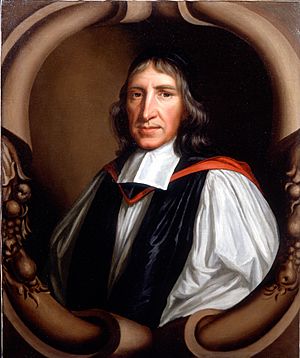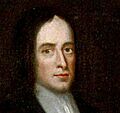John Lake (bishop) facts for kids
Quick facts for kids The Right Reverend John Lake |
|
|---|---|
| Bishop of Chichester | |

Portrait by Mary Beale
|
|
| Diocese | Diocese of Chichester |
| In Office | 1685–1689 |
| Predecessor | Guy Carleton |
| Successor | Simon Patrick |
| Other posts | Bishop of Sodor and Man (1682–1684) Bishop of Bristol (1684–1685) |
| Orders | |
| Ordination | 1647 |
| Personal details | |
| Born | baptized 5 December 1624 Halifax, West Riding of Yorkshire |
| Died | 30 August 1689 (aged 64) |
| Buried | St Botolph-without-Bishopsgate |
| Nationality | British |
| Denomination | Anglican |
| Alma mater | St John's College, Cambridge |
John Lake (1624 – 30 August 1689) was an important church leader in the 1600s. He served as a bishop in different parts of the British Isles. He was the Bishop of Sodor and Man, then Bristol, and finally Chichester. He is best known for being one of the "Seven Bishops" who stood up to King James II.
Contents
John Lake's Early Life
John Lake was born in Halifax, a town in Yorkshire, England, in 1624. He went to St John's College, Cambridge, for his education. There, a famous poet named John Cleveland was his teacher. John Lake later wrote a book about his teacher and helped publish his poems. He finished his first degree in 1642.
A Supporter of the King
During a time of civil war in England, John Lake was a strong supporter of King Charles I. People who supported the King were called Royalists. John Lake even fought in battles for the King. He bravely took part in fights at places like Basing House and Wallingford.
Joining the Church
After leaving the army, John Lake decided to become a priest. He was ordained, meaning he officially became a priest, in 1647. Later, in 1661, he earned a special advanced degree called a Doctor of Divinity from Cambridge.
Over the years, he held many important jobs in the church:
- He was the Vicar of Leeds from 1661 to 1663.
- He became the Rector of St Botolph-without-Bishopsgate from 1663 to 1670.
- He also served as a Prebendary (a type of church official) at St Paul's Cathedral and York Minster.
- From 1680 to 1682, he was the Archdeacon of Cleveland, which is a senior church role.
Becoming a Bishop
John Lake continued to rise in the church. On 7 January 1683, he was made the Bishop of Sodor and Man. A bishop is a senior leader in the Christian church, overseeing many churches in a specific area.
He then moved to other important bishop roles:
- On 12 August 1684, he became the Bishop of Bristol.
- On 19 October 1685, he was appointed the Bishop of Chichester.
The Seven Bishops' Stand
John Lake is famous for being one of the Seven Bishops. These bishops bravely stood up to King James II. The King had issued something called the "Declaration of Indulgence" in 1687. This declaration aimed to give more religious freedom, but many people, including the bishops, worried it was a way for the King to bring back Catholicism to England.
The Seven Bishops refused to support the King's declaration. Because of their opposition, King James II had them arrested and put in prison. This event caused a lot of public anger and made the King very unpopular.
A New King and Queen
Later, during the Glorious Revolution, King James II was removed from power. William and Mary became the new King and Queen of England. John Lake, however, did not agree with this change. He refused to accept William and Mary as the new rulers.
Because of his refusal, he was suspended from his duties as bishop on 1 August 1689. John Lake died shortly after, on 30 August 1689.
Images for kids
-
Bishop Lake, from a portrait of the "Seven Bishops".


